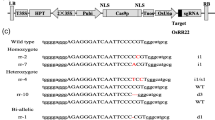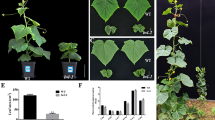Abstract
Abiotic stresses have adverse effects on plant growth and productivity. The homologous RD29A and RD29B genes are exquisitely sensitive to various abiotic stressors. Therefore, RD29A and RD29B gene sequences have potential to confer abiotic stress resistance in crop species grown in arid and semi-arid regions. To our knowledge, no information on the physiological roles of the proteins encoded by RD29A and RD29B are available in the literature. To understand how these proteins function, we used reverse genetic approaches, including identifying rd29a and rd29b T-DNA knockout mutants, and examining the effects of complementing transgenes with the genes under control of their native promoters and chimeric genes with the native promoters swapped. Four binary vectors with the RD29A and RD29B promoters upstream of the cognate RD29A and RD29B cDNAs and as chimeric genes with noncognate promoters were used to transform rd29a and rd29b plants. Cold, drought, and salt induced both genes; the promoter of RD29A was found to be more responsive to drought and cold stresses, whereas the promoter of RD29B was highly responsive to salt stress. Morphological and physiological responses of rd29a and rd29b plants to salt stress were further investigated. Root growth, and photosynthetic properties declined significantly, while solute concentration (Ψπ), water use efficiency (WUE) and δ13C ratio increased under salt stress. Unexpectedly, the rd29a and rd29b knockout mutant lines maintained greater root growth, photosynthesis, and WUE under salt stress relative to control. We conclude that the RD29A and RD29B proteins are unlikely to serve directly as protective molecules.







Similar content being viewed by others
Abbreviations
- A :
-
Photosynthesis (μmol m−2 s−1)
- ABA:
-
Abscisic acid
- ABRE:
-
Abscisic acid-responsive element
- AREB:
-
Abscisic acid-responsive element-binding protein
- CaMV:
-
Cauliflower mosaic virus
- CDPK:
-
Calcium-dependent protein kinase
- COR:
-
Cold-regulated
- DRE:
-
Dehydration-responsive element
- DREB:
-
Dehydration-responsive element-binding protein
- E :
-
Transpiration (mmol m−2 s−1)
- GFP:
-
Green fluorescent protein
- GUS:
-
Beta-glucuronidase
- LEA:
-
Late embryogenesis abundant
- LTI:
-
Low temperature induced
- MAP:
-
Mitogen activated protein
- MS:
-
Murashige–Skoog
- PAR:
-
Photosynthetically active radiation (μmol m−2 s−1)
- RD :
-
Responsive to desiccation
- RH:
-
Relative humidity
- rd29a :
-
RD29A knockout mutant
- rd29b :
-
RD29B knockout mutant
- RT-PCR:
-
Reverse transcriptase polymerase chain reaction
- T :
-
Temperature
- TF:
-
Transcription factor
- WUE:
-
Water use efficiency
- δ13C:
-
Carbon isotope ratio (‰)
- Ψπ :
-
Osmotic potential (MPa)
References
Baker SS, Wilhelm KS, Thomashow MF (1994) The 50-region of Arabidopsis thaliana cor15a has cis-acting elements that confer cold-, drought- and ABA-regulated gene expression. Plant Mol Biol 24:701–713
Bray E, Bailey-Serres J, Weretilnyk E (2000) Responses to abiotic stresses. In: Buchanan B, Gruissem W, Jones R (eds) Biochemistry and molecular biology of plants. American Society of Plant Biologists, Rockville, pp 1158–1203
Clark H, Newton PCD, Barker DJ (1999) Physiological and morphological responses to elevated CO2 and a soil moisture deficit of temperate pasture species growing in an established plant community. J Exp Bot 50:233–242
Cook D, Fowler S, Fiehn O, Thomashow MF (2004) A prominent role for the CBF cold response pathway in configuring the low temperature metabolome of Arabidopsis. Proc Natl Acad Sci USA 101:15243–15248
Cutler SR, Ehrhardt DW, Griffitts JS, Somerville CR (2000) Random GFP:cDNA fusions enable visualization of subcellular structures in cells of Arabidopsis at a high frequency. Proc Natl Acad Sci USA 97:3718–3723
Dubey RS (2005) Photosynthesis in plants under stressful conditions. In: Pessarakli M (ed) Handbook of photosynthesis, 2nd edn. CRC Press, New York, pp 717–737
Dubouzet JG, Sakuma Y, Ito Y, Kasuga M, Dubouzet EG, Miura S, Seki M, Shinozaki K, Yamaguchi-Shinozaki K (2003) OsDREB genes in rice, Oryza sativa L., encode transcription activators that function in drought-, high-salt- and cold-responsive gene expression. Plant J 33:751–763
Fujita Y, Fujita M, Satoh R, Maruyama K, Parvez MM, Seki M, Hiratsu K, Ohme-Takagi M, Shinozaki K, Yamaguchi-Shinozaki K (2005) AREB1 is a transcription activator of novel ABRE-dependent ABA signaling that enhances drought stress tolerance in Arabidopsis. Plant Cell 17:3470–3488
Gilmour SJ, Zarka DG, Stockinger EJ, Salazar MP, Houghton JM, Thomashow MF (1998) Low temperature regulation of the Arabidopsis CBF family of AP2 transcriptional activators as an early step in cold-induced COR gene expression. Plant J 16:433–442
Gilmour SJ, Fowler SG, Thomashow MF (2004) Arabidopsis transcriptional activators CBF1, CBF2, and CBF3 have matching functional activities. Plant Mol Biol 54:767–781
Goodin MM, Dietzgen RG, Schichnes D, Ruzin S, Jackson AO (2002) pGD vectors: versatile tools for the expression of green and red fluorescent protein fusions in agroinfiltrated plant leaves. Plant J 31:375–383
Kasuga M, Liu Q, Miura S, Yamaguchi-Shinozaki K, Shinozaki K (1999) Improving plant drought, salt, and freezing tolerance by gene transfer of a single stress-inducible transcription factor. Nat Biotechnol 17:287–291
Kaur N, Gupta AK (2005) Signal transduction pathways under abiotic stresses in plants. Curr Sci 88:1771–1780
Koornneef M, Reuling G, Karssen C (1984) The isolation and characterization of abscisic acid-insensitive mutants of Arabidopsis thaliana. Physiol Plant 61:377–383
Koornneef M, Jorna ML, Brinkhorst-van der Swan DLC, Karssen CM (1992) The isolation of abscisic acid (ABA)-deficient mutants by selection of induced revertants in non-germinating gibberellins sensitive lines of Arabidopsis thaliana (L.). Heynh. Theor. Appl Genet 61:385–393
Koyro HW (2006) Effect of salinity on growth, photosynthesis, water relations and solute composition of the potential cash crop halophyte Plantago coronopus (L.). Environ Exp Bot 56:136–146
Lambers H (2003) Dryland salinity: a key environmental issue in southern Australia. Plant Soil 257:5–7
Liu Q, Kasuga M, Sakuma Y, Abe H, Miura S, Yamaguchi-Shinozaki K, Shinozaki K (1998) Two transcription factors, DREB1 and DREB2, with an EREBP/AP2 DNA binding domain, separate two cellular signal transduction pathways in drought- and low temperature-responsive gene expression, respectively, in Arabidopsis. Plant Cell 10:1391–1406
Mudrik V, Kosobrukhov A, Knyazeva I, Pigulevskaya T (2003) Changes in the photosynthetic characteristics of Plantago major plants caused by soil drought stress. Plant Growth Regul 40:1–6
Nemhauser JL, Hong F, Chory J (2006) Different plant hormones regulate similar processes through largely non-overlapping transcriptional responses. Cell 126:467–475
Novillo F, Alonso JM, Ecker JR, Salinas J (2004) CBF2/DREB1C is a negative regulator of CBF1/DREB1B and CBF3/DREB1A expression and plays a central role in stress tolerance in Arabidopsis. Proc Natl Acad Sci USA 101:3985–3990
Sakuma Y, Liu Q, Dubouzet JG, Abe H, Shinozaki K, Yamaguchi-Shinozaki K (2002) DNA-binding specificity of the ERF/AP2 domain of Arabidopsis DREBs, transcription factors involved in dehydration- and cold-inducible gene expression. Biochem Biophys Res Comm 290:998–1009
Sakuma Y, Maruyama K, Osakabe Y, Qin F, Seki M, Shinozaki K, Yamaguchi-Shinozaki K (2006a) Functional analysis of an Arabidopsis transcription factor, DREB2A, involved in drought-responsive gene expression. Plant Cell 18:1292–1309
Sakuma Y, Maruyama K, Qin F, Osakabe Y, Shinozaki K, Yamaguchi-Shinozaki K (2006b) Colloquium Paper: Dual function of an Arabidopsis transcription factor DREB2A in water-stress-responsive and heat-stress-responsive gene expression. Proc Natl Acad Sci USA 103:18822–18827
Schob H, Kunz C, Meins F Jr (1997) Silencing of transgenes introduced into leaves by agroinfiltration: a simple, rapid method for investigating sequence requirements for gene silencing. Mol Gen Genet 256:581–585
Shinozaki K, Yamaguchi-Shinozaki K (2007) Gene networks involved in drought stress response and tolerance. J Exp Bot 58:221–227
Shinozaki K, Yamaguchi-Shinozaki K, Seki M (2003) Regulatory network of gene expression in the drought and cold stress responses. Curr Opin Plant Biol 6:410–417
Shinwari ZK, Nakashima K, Miura S, Kasuga M, Seki M, Yamaguchi-Shinozaki K, Shinozaki K (1998) An Arabidopsis gene family encoding DRE/CRT binding proteins involved in low-temperature-responsive gene expression. Biochem Biophys Res Comm. 250:161–170
Smirnoff N, Bryant JA (1999) DREB takes the stress out of growing up. Nat Biotechnol 17:229–230
Stockinger EJ, Gilmour SJ, Thomashow MF (1997) Arabidopsis thaliana CBF1 encodes an AP2 domain-containing transcriptional activator that binds to the C-repeat/DRE, a cis-acting DNA regulatory element that stimulates transcription in response to low temperature and water deficit. Proc Natl Acad Sci USA 94:1035–1040
Stone JM, Liang X, Nekl ER, Stiers JJ (2005) Arabidopsis AtSPL14, a plant-specific SBP-domain transcription factor, participates in plant development and sensitivity to fumonisin B1. Plant J 41:744–754
Thomashow MF (1999) Plant cold acclimation: freezing tolerance genes and regulatory mechanisms. Annu Rev Plant Physiol Plant Mol Biol 50:571–599
Toufighi K, Brady SM, Austin R, Ly E, Provart NJ (2005) The Botany Array Resource: e-Northerns, Expression Angling, and promoter analyses. Plant J 43:153–163
Wang Q, Guan Y, Wu Y, Chen H, Chen F, Chu C (2008) Overexpression of a rice OsDREB1F gene increases salt, drought, and low temperature tolerance in both Arabidopsis and rice. Plant Mol Biol 67:589–602
Xiong L, Schumaker KS, Zhu JK (2002) Cell signaling during cold, drought, and salt stress. Plant Cell (Suppl) S165–S183
Yamaguchi-Shinozaki K, Shinozaki K (1993a) Arabidopsis DNA encoding two desiccation-responsive rd29 genes. Plant Physiol 101:1119–1120
Yamaguchi-Shinozaki K, Shinozaki K (1993b) Characterization of the expression of a desiccation-responsive rd29 gene of Arabidopsis thaliana and analysis of its promoter in transgenic plants. Mol Gen Genet 236:331–340
Yamaguchi-Shinozaki K, Shinozaki K (1994) A novel cis-acting element in an Arabidopsis gene is involved in responsiveness to drought, low-temperature, or high-salt stress. Plant Cell 6:251–264
Yamaguchi-Shinozaki K, Koizumi M, Urao S, Shinozaki K (1992) Molecular cloning and characterization of 9 cDNAs for genes that are responsive to desiccation in Arabidopsis thaliana: sequence analysis of one cDNA clone that encodes a putative transmembrane channel protein. Plant Cell Physiol 33:217–224
Yang Y, Li R, Qi M (2000) In vivo analysis of plant promoters and transcription factors by agroinfiltration of tobacco leaves. Plant J 22:543–551
Zhang JZ, Creelman RA, Zhu JK (2004) From laboratory to field. Using information from Arabidopsis to engineer salt, cold, and drought tolerance in crops. Plant Physiol 135:615–621
Zhu JK (2002) Salt and drought stress signal transduction in plants. Annu Rev Plant Biol 53:247–273
Zimmermann P, Hirsch-Hoffmann M, Hennig L, Gruissem W (2004) GENEVESTIGATOR. Arabidopsis microarray database and analysis toolbox. Plant Physiol 136:2621–2632
Zimmermann P, Hennig L, Gruissem W (2005) Gene-expression analysis and network discovery using Genevestigator. Trends Plant Sci 10:407–409
Acknowledgments
We are grateful to the LICOR Inc. (Lincoln, NE) for providing the LI-6400-17 WPA Arabidopsis gas exchange chamber, Dr. S. Madhavan for the carbon isotope ratio determinations, and Christian Elowsky for his microscopy expertise. This work was supported by an Interdisciplinary Agriculture Research grant, ARD-University of Nebraska-Lincoln. J. Msanne would like to acknowledge the graduate scholarship from the School of Natural Resources, University of Nebraska-Lincoln.
Author information
Authors and Affiliations
Corresponding author
Rights and permissions
About this article
Cite this article
Msanne, J., Lin, J., Stone, J.M. et al. Characterization of abiotic stress-responsive Arabidopsis thaliana RD29A and RD29B genes and evaluation of transgenes. Planta 234, 97–107 (2011). https://doi.org/10.1007/s00425-011-1387-y
Received:
Accepted:
Published:
Issue Date:
DOI: https://doi.org/10.1007/s00425-011-1387-y




